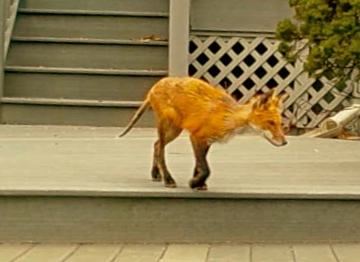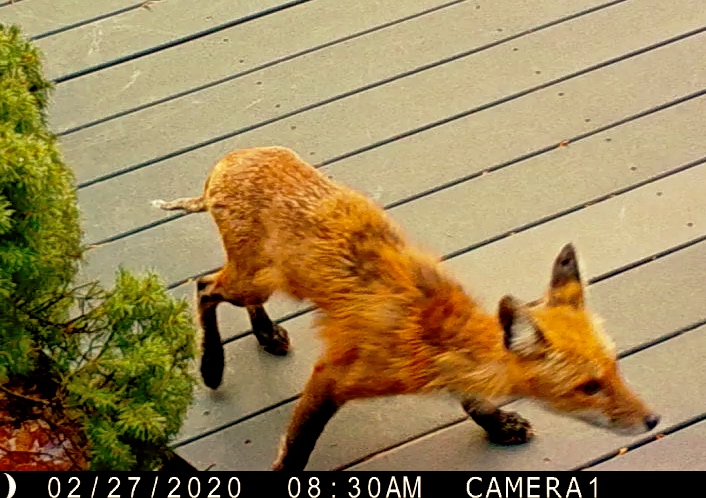Author: Elise Able
I Think I Saved This Fox’s Life
Wow! Thank you Jim from New Jersey for sharing your wonderful story about saving this fox with Sarcoptic mange using the guidelines we created and posted on our website. Please check out our article about using Ivermectin to heal You truly did save this foxe’s life, and are an inspiration to others who also want to do something for a fox in need <3 <3 <3 <3 <3 Check out our facebook page as well
I Think I saved this fox’s life.
I live in Northern New Jersey in a small town only about 30 minutes from New York City. Because my property backs up to a 1,400 acre “Green Acres” preserve, seeing lots of wildlife in my yard is not at all unusual.
In early January this year, a red fox showed up on my front deck. The previous Spring I had a female and her three kits living in an abandoned woodchuck burrow under this deck so seeing a red fox out there not a surprise. What did surprise was how sick he looked (severe loss of fur and numerous sores on his body).
I did some research and found an article on your web site, “Treating Sarcoptic Mange in Red Foxes”. Following the advice in the article, I ordered the Agrimectin and the recommended syringes. I began leaving a small amount of dog food and some hamburger twice a day to attract him to the same spot. Every third day I would inject the dog food with the Agrimectin. “Mangy”, as I named him, came like clockwork. I also set up a couple trail cams to make sure it was Mangy that was eating the food. By mid February I could see a definite change with all the bare spots filling in with fur (though his tail still looked a bit like a “rope”). By the end of February, even his tail started to show signs of fur growing on it. I stopped the medicine around this time but still left him some food so that I could monitor his recovery and make sure the mites did not come back.
He looked quite healthy through most of March. I then stopped feeding him so that he wouldn’t become dependent on my food and would hunt for himself. He still came back at least twice a night or early morning to check for food for several weeks. Now he comes maybe every three or four days.
I’m sending a series of pictures. The first five are from early January when I first began to film him. The second five are from mid to late February. The last is from April 20. They are screenshots from videos so they are not as crisp as a regular photo might be. I think I save Mangy’s life. Thank you for posting that article.
Jim from New Jersey








Couple in Wisconsin Successfully treat a red fox for Sarcoptic mange
Fox Pups Are Born Now!
T he Momma foxes are working hard to bring home food for their young. They are working 24/7, day and night. Please remember that Red foxes are NOT NOCTURNAL! It is normal to see them at all times of the day. The moms are working especially hard to catch mice, squirrels, rats and rabbits to feed themselves and their young. They are working so hard and are so focused that they will trot right past you, through your yard, past your dogs and cats as they move from their hunting grounds to their den. They are not interested in eating your dogs or cats.
he Momma foxes are working hard to bring home food for their young. They are working 24/7, day and night. Please remember that Red foxes are NOT NOCTURNAL! It is normal to see them at all times of the day. The moms are working especially hard to catch mice, squirrels, rats and rabbits to feed themselves and their young. They are working so hard and are so focused that they will trot right past you, through your yard, past your dogs and cats as they move from their hunting grounds to their den. They are not interested in eating your dogs or cats.
A Red fox will chase a cat that gets too close to her den- Cats are very curious and often end up in places they shouldn’t be. A momma fox is concerned about having a cat too close to her pups, so she will chase kitty right back home, up onto your porch or tree it. She isn’t interested in eating your cat – she just wants it to go away from her pups. Please keep in mind, for the safety of your cat from other predators such as great -Horned Owls who now have hungry young in the nest, keep your cat indoors, especially at dusk and dawn when owls are hunting.
If you have a fox den, or even a skunk or raccoon with young that are in a place where you don’ want them, such as under a porch or back yard shed, its easy to convince mom to move her babies! Coyote urine is easily purchased online (and in special circumstances, picked up, free, from us!) and no momma wants to raise her young where a coyote is hunting. I simply put coyote urine infused pine shavings in the area where the unwanted family is. They generally are gone in the morning! Trying to Live trap and “relocate” a family of foxes, skunks or raccoons is a futile effort and usually ends up creating orphans. Try the coyote urine- it works, and is humane because Momma moves the family to a different place all by herself.
Treating Sarcoptic Mange in Red Foxes – Short Version
What you will need:
Bravecto Chew for a dog , a piece for a ten pound dog. Can be divided from a larger chew. For example, the 22-44 lb size can be divided into 4 pieces and treat 4 foxes! Can be purchased without a prescription outside of the USA online!!! One single dose will treat the fox, and protect it for three months. Slip the piece inside of a nice warm meatball.
https://www.bestvetcare.com/bravecto-for-medium-dogs-22-44-lbs-green-pack-103.aspx
or, you can use Ivermectin Injection for Cattle and Swine 1% Sterile Solution. You will need to give the fox multiple doses of this orally over the course of a month or two. Since Ivermectin stays in the body for 4 days, once every 5 days for one month will work.
WARNING! Use ONLY the INJECTABLE Ivermectin NOT the “POUR ON”, as the agents for carrying the pour-on through the skin are highly toxic if ingested! If anyone tells you differently, they do not know what they are doing! Do not use the Horse wormer paste!
WARNING! Ivermectin can be deadly to collie breeds of dogs, such as Collies, Shelties, Border Collies, Australian Shepherds and high mixes of these breeds. Please be sure before you treat a fox, that there is no chance one of these breeds can have access to the medicated food or medication.
14 or 16 Gauge needle and 3 ml syringe
1 package frozen all beef meatballs
Dry Cat food
Directions:
Step 1: Put Dry cat food on the ground in the same place every day for the fox.
Step 2: Heat up around 6 frozen meatballs, and inject each meatball with 0.2 ml Ivermectin
Step 3: Place 1 treated meatball on top of the cat food, place the other meatballs in the refrigerator.
Step 4: Every 5 days, place another treated meatball on the cat food. Do this for 3 weeks.
Step 5: Every 10 days place another treated meatball on the cat food. Do this for three more weeks.
Consideration: If you are not sure the fox is getting the meatball with the medication in it, or there are more than one ill fox, put one meatball on the cat food pile, and toss two other treated meatballs in different directions, about 50 feet from each other.
 Agri-Mectin is a generic injectible ivermectin available on Amazon.com It comes in a 50 Ml bottle for roughly $32 it contains enough Ivermectin to treat hundreds of foxes, so it will be plenty! When you purchase the Agri-Mectin or any other bottle of Ivermectin, it comes with a rubber stopper that you will need a syringe to draw the liquid out.
Agri-Mectin is a generic injectible ivermectin available on Amazon.com It comes in a 50 Ml bottle for roughly $32 it contains enough Ivermectin to treat hundreds of foxes, so it will be plenty! When you purchase the Agri-Mectin or any other bottle of Ivermectin, it comes with a rubber stopper that you will need a syringe to draw the liquid out.
 Here are the best blunt needles and 1 mL syringes available on Amazon.com to use : 1mL Syringe with 18Ga 1.5″ Blunt Needle and Plastic Needle with Matching Cap (Pack of 10) . They are a 1mL Syringe , so you can easily measure 0.2 Ml, just draw the ivermectin to the “.2” near the opening of this syringe. You just need a drop!
Here are the best blunt needles and 1 mL syringes available on Amazon.com to use : 1mL Syringe with 18Ga 1.5″ Blunt Needle and Plastic Needle with Matching Cap (Pack of 10) . They are a 1mL Syringe , so you can easily measure 0.2 Ml, just draw the ivermectin to the “.2” near the opening of this syringe. You just need a drop!
Evicting a Family of Foxes from Your Yard
Foxes will often come in close to humans to raise their young , choosing the lesser of two perceived evils- human danger or coyote danger. Because they compete for the same food source, a coyote may kill young foxes to make sure there is plenty of food for her own pups. Foxes will often choose to have their pups close to humans, where the coyotes are less likely to find them when they are very young. As the pups get older, usually around June or July, they are more able escape a coyote on their own, and the coyotes are too busy raising their own families to bother much with foxes anymore. At this time, the young foxes will leave the safety of the yard for more wild places. soon after that, usually starting in September, the foxes will disperse, often travelling more than 100 miles to find a new territory.
Watching a fox family grow up is a very safe, entertaining and educational way to enjoy Spring and part of Summer. Before you decide to evict the family, consider allowing them to rent your space, and in turn, you and possibly your neighbors will have a rodent free yard and what will most likely be your best gardens ever. In addition, you may also be able to take some very beautiful photos and cute videos!
A healthy fox family won’t hurt children or pets. The most a protective action a parent fox might take is chase a domestic cat that gets too close to her babies back to your back deck or up a tree. Foxes don’t want to kill or eat your dogs, cats or kids. The average fox rarely tops 11 pounds. It is very important to know that a mother fox will hunt all times of the day and night. Often the male will leave early on, leaving the female to work very hard, hunting 24/7 to bring back food for her growing pups.Unfortunately, humans who don’t know this will be alarmed to see a fox running through their yard during the day and sometimes extreme action such as shooting the mother fox will be taken, creating orphans. Because momma foxes are often crossing roads more often, sometimes she will be hit by a car. If this happens, a trail cam to make sure that the pups are indeed orphaned will help to determine what action to take if any. Often orphaned pups are old enough to survive and leave on their own. Contacting a knowledgeable Wildlife Rehabilitator at this time can help determine the best course of action.
If you choose to convince the foxes to move, the earlier you do it, the better. The older the family gets, the less the female is sensitive to interference. Because a mother fox is concerned about coyotes, using coyote urine in the area will make her think a coyote is around. It is very likely she will move her pups within days to a new secret location far from the “marked” area. Sprinkle the coyote urine around the den area. Again, the younger the pups are, the more effective this is.
Putting a foreign object such as a chair near the den may also help convince mom that her den has been discovered. However, keep in mind we don’t want to frighten her too much so that she isn’t comfortable retrieving her pups and we want to make sure she has a clear and safe entrance and exit to get them out one by one. Often simply increasing your activity in the area works. Don’t be afraid to use your deck, mow your lawn, do your gardening. Mother foxes aren’t aggressive protectors like grizzly bears. The most they will do is stand at a distance, watching you and bark a warning for her pups to take cover because danger is near. This is not a warning to you, it is a warning to her pups- YOU are the danger.
Balloons are very scary to foxes, especially when they move in the breeze. Punch balloons, sold as children’s toys are inexpensive and hardy and when a small handful of beads or pebbles are placed inside them before inflated, they make scary noises too! When placed appropriately about 2 feet off the ground, they will discourage a fox from coming into or traveling through your yard.
Hiring a Nuisance Control company to trap and remove the foxes rarely works out well for the foxes or your pocketbook. Only the very young will be captured, and usually only a few. The parents will not be easy to catch, and relocation is not going to work. Most likely all that will happen is the fox family will be fragmented or destroyed and you will spend a lot of money. “Relocation” of a fox family by a trapper is not realistic, so please don’t fall for that. You will be wasting your money. As suggested earlier in this piece, to convince the female to relocate her own family using one or all of these methods mentioned is the most effective and humane way.
Most likely, the family will be gone by late June or July. Foxes only use a den to raise their families, and the rest of the year, they are nomads, napping under trees and wherever they find a quiet place. If you don’t want them back again next year, mid-July is the time to do repairs and permanent exclusion from the area with strong fencing, concrete block, or rocks. This will prevent not only foxes, but skunks, raccoons and woodchucks from using the space to raise their young.
Snared Red fox
We don’t need to tell anyone how deadly and dangerous snares are for all animals , both wild and domestic.. This beautiful male red fox got caught in an improperly and illegally set snare trap. The wire cut deep into his neck as he ran with the device until the stake got snagged on a fence. He was discovered by a homeowner who called for help. the wire was cut off of his neck, but not before significant damage was done. Though the fox was free of the wire, it had dug so deeply into his neck that nerve damage affected not only his eye, but his trachea. Because of the nature of this damage, he had to be humanely euthanized. Did you know that there is a bill currently being sponsored by the trapping associations to legalize these horrific snares in New York? What a step back this would be. 
Eastern Coyote with Sarcoptic Mange gets a Second Chance
This sweetheart was found in Orchard Park, NY, dying from a nasty skin infection brought on by Sarcoptic Mange mites. She was treated for the infection with a long-acting antibiotic, given life-saving fluids and mange medicine was applied. She is presently being cared for at Fox Wood, and is a model patient – compliant and gentle. Because the Mange and infection creates a situation where they are also starving, she is being fed small amounts of easily digested food many times a day. Please check out our wishlist on Amazon.com if you would like to contribute to her care. We are also accepting donations through PayPal (foxladye@yahoo.com). We are hoping to be able to release her in Spring .
Treating Sarcoptic Mange in Red foxes
 Please watch the YouTube video at the end of this article to see the treatment outlined on this page being used on a Red fox on Long Island- watch his transformation from sick back to healthy again!
Please watch the YouTube video at the end of this article to see the treatment outlined on this page being used on a Red fox on Long Island- watch his transformation from sick back to healthy again!
I often get calls and e-mails from people who have a Red fox around that is acting lethargic or unfearful of humans. They will stay close to houses and will eat under the bird feeders, seek refuge under decks and often lay in the hay in barns. A scruffy, thin appearance usually indicates that the fox has Sarcoptic mange.
Sarcoptic mange is the name for the skin disease caused by infection with the Sarcoptes scabei mite. The mites are microscopic and can’t be seen by the naked eye. Female Sarcoptes mites burrow under the skin and leave a trail of eggs behind. This burrowing creates an inflammatory response in the skin similar to an allergic reaction. The motion of the mite in and on the skin is extremely itchy, as is the hatching of the eggs. This creates a further allergic reaction and more itching, loss of sleep and reduced immune response. Loss of fur, scaly skin and a general unthrifty appearance is characteristic of a Sarcoptic mange infestation. The condition worsens as a skin infection sets in. The foxes immune system is even more compromised and internal parasites (tape, hook and roundworms) begin to take over and absorb any nutrients that fox may find. Mangy foxes are usually starving in the late stages.
These foxes are not a threat to people, dogs, cats, etc. They are close to people and buildings because there may be easy food such as cat or dog food left out in dishes, bird seed, garbage, insects, worms, roadkill and a mouse or two. They are also losing their ability to thermoregulate and need protection from wind, shade, sun, whatever the present need of the body is. Mangy foxes (and coyotes) often seek out a pile of hay to lay in. Hay seems to relieve the itchiness and provide a source of comfort.
Sarcoptic mange is treatable if the animal is treated in time before the process of organ failure begins. The drug of choice is inexpensive and easy to obtain. Although it is an “off-label use” according to the FDA, Ivermectin injection for cattle and pigs is a very effective cure for Sarcoptic mange in foxes. This injectable solution works orally and can easily be slipped into food. The ivermectin also treats a lot of the intestinal worms and any ear mites. The catch is this: it kills the mites living on the skin but doesn’t kill the eggs. These eggs will hatch and reinfect the fox, so it has to be administered many times to kill the mange mites that hatch after treatment. A less expensive injectable version of Ivermectin such as Ivermax 1 %, Agrimectin or Noromectin 1% are all readily available online and in some farm stores. I strongly recommend treating Red foxes very aggressively, giving them the Ivermectin every five days for the first three weeks. After the first three weeks, you can dose them every ten days. Be sure to treat them for at least 4-5 weeks. A daily feeding station using dry cat or dog food can be set up to facilitate the administration of tasty treats laced with ivermectin. Frozen all beef meatballs with no spices work great and when they are warmed up, are easy to inject the medication into. A spoonful of canned cat food, a hard-boiled egg, a chunk of cooked chicken or a section of hot dog can also easily be injected with the ivermectin.
Frequently more than one fox or wild animal is coming to your yard. I recommend injecting several different pieces of food with 0.2 ml and tossing them in different directions, at least 100 feet or so apart, in the hope that one animal might find one piece, but not the other. Ivermectin is fairly safe, and if a fox happens to get more than one dose in a day, it will be fine. Meatballs work great for this! Be sure to use the meatballs with the least amount of spices (Italian style meatballs are too spicy!)
Figure your fox weighs 10 lbs, so give him 0.2 mL for each dose. Many people think they are much larger, but they aren’t. For young foxes in April or May you can cut the dose in half. You will need a large needle to draw the solution out of the bottle because the solution is rather thick. Ivermectin is a non-prescription product and available online through Amazon.com Here is a link and a picture of the products I recommend:
 Agri-Mectin is a generic injectible ivermectin available on Amazon.com It comes in a 50 Ml bottle for roughly $32 it contains enough Ivermectin to treat hundreds of foxes, so it will be plenty! When you purchase the Agri-Mectin or any other bottle of Ivermectin, it comes with a rubber stopper that you will need a syringe to draw the liquid out.
Agri-Mectin is a generic injectible ivermectin available on Amazon.com It comes in a 50 Ml bottle for roughly $32 it contains enough Ivermectin to treat hundreds of foxes, so it will be plenty! When you purchase the Agri-Mectin or any other bottle of Ivermectin, it comes with a rubber stopper that you will need a syringe to draw the liquid out.
 Here are the best blunt needles and 1 mL syringes available on Amazon.com to use : 1mL Syringe with 18Ga 1.5″ Blunt Needle and Plastic Needle with Matching Cap (Pack of 10) . They are a 1mL Syringe , so you can easily measure 0.2 Ml, just draw the ivermectin to the “.2” near
Here are the best blunt needles and 1 mL syringes available on Amazon.com to use : 1mL Syringe with 18Ga 1.5″ Blunt Needle and Plastic Needle with Matching Cap (Pack of 10) . They are a 1mL Syringe , so you can easily measure 0.2 Ml, just draw the ivermectin to the “.2” near
WARNING: Use ONLY the INJECTABLE Ivermectin NOT the “POUR ON”, as the agents for carrying the pour-on through the skin are highly toxic if ingested! If anyone tells you differently, they do not know what they are doing!
WARNING! Ivermectin can be deadly to collies and mixes of collies, Make sure that Border Collies, Shelties, Australian Shepherds, smooth and rough collies and mixes of these dogs do not have access to the medication or treated food
Of course, other wildlife might get to the food before the fox does, so try to use your judgment and administer it the best way that will target only the fox. Placing a leaf or a little grass over the baited food will lower the risk of it being seen and eaten by crows. Using hard-boiled eggs will decrease the chances of the food being eaten by cats. Ivermectin is a pretty safe drug and won’t harm most wildlife. Some breeds of dogs can be very sensitive to it, particularly the collie family and Australian shepherds. Don’t use ivermectin if there is a chance a collie breed might eat the bait. Use extra caution around domestic animals. They use Ivermectin in third world countries to treat different things, such as scabies in humans. Ivermectin is also used to treat dogs for mange, and it is also a good wormer for many animals.
UPDATE: a prescription pet product called Bravecto can also be used, and only takes one single dose. Figure the dose for a ten pound dog/ fox. Give only once in a small, warm meatball or other item the fox will eat. One Bravecto will cure your fox and protect it for 3 months. For a coyote, use a piece representative of a 30 or 40 pound dog/coyote. Nexguard and Simparica , another two prescription products can also be used, again, by weight, but two doses, one month apart are best. Some people put their pets on these products for the summer, and often, a little piece to save a fox can be broken off first before administering it to your dog. Just a thought… Most vets will not prescribe e medication for a fox to you.
Bravecto Chew for a dog , a piece for a ten pound dog. Can be divided from a larger chew. For example, the 22-44 lb size can be divided into 4 pieces and treat 4 foxes! Can be purchased without a prescription outside of the USA online!!! One single dose will treat the fox, and protect it for three months. Slip the piece inside of a nice warm meatball.
https://www.bestvetcare.com/bravecto-for-medium-dogs-22-44-lbs-green-pack-103.aspx
Select topical products Advantage Multi and Revolution can be obtained from your veterinarian and used to help protect your domestic dogs from picking up mange in the grass surrounding your property. I have found Advantage Multi and Revolution to be very effective preventatives for mange in dogs, but very ineffective cures for mange, unless applied every two weeks during the month for at least 6 weeks. I apply Advantage Multi to all my foxes just before they are released back to the wild as a preventative measure for them.
 Can people get mange? You bet, but it won’t live and reproduce on your skin. It will give you one heck of an itchy red allergic reaction if you are sensitive to mange mites though.
Can people get mange? You bet, but it won’t live and reproduce on your skin. It will give you one heck of an itchy red allergic reaction if you are sensitive to mange mites though.
Please watch the beautiful short video on Youtube made by a gentleman on Long Island who was able to videotape his treatment of a Red fox with mange in his back yard. He used the treatment outlined above. Below that find a new video made by a gentleman named Jim about how he treated his fox “Mangey” as well. Thank you for taking the time to make and send us the videos!
Update on Twister, the Border Collie
As you many of you know, I adopt the dogs from work who are not claimed by anyone. Quite often dogs who are unclaimed have behavioral issues, and this is why they were abandoned. Twister is no exception. After being returned by two adopters because of his extreme issues, I have invested a large amount of money into professional training for Twister. Because some of his issues are related to inherited traits of the breed, it is a very complicated situation- there must be a balance between understanding his drives, and reeling them in to make them less extreme and his behavior more acceptable. Our ultimate goal is to make Twister a more adoptable, well mannered dog that can be placed in a home suitable for his breed. He needs an active farm type home with other Border Collies, and an experienced Border Collie savvy owner. I would appreciate any donations that folks could make toward Twisters continued training sessions. If you would like to donate toward Twisters rehabilitation, you can donate through paypal at foxladye@yahoo.com. Donations can also be mailed to: 11156 Old Glenwood Road, East Concord, NY 14055. be sure to specify “Twister” on your check and that donation will be applied directly to his fund







